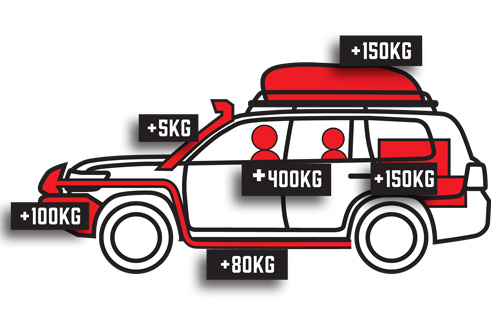
Every outdoor enthusiast and 4WD owner knows how quickly additional weight can add up - bullbar, rear bar, tyre swing out, rock sliders, roof rack, and other accessories all contribute to an increased Gross Vehicle Mass (GVM). Add to that the luggage in the boot and on the roof and a bunch of people, and before you know it you have almost put an extra tonne of weight on your vehicle (always make sure not to extend the legal GVM!). If you then decide to tow along an unbraked trailer, you are looking at the next three quarters of a tonne. So your vehicle’s brakes are now dealing with an extra 50%+ of weight that need to be stopped.
Whilst most OE-fitted brakes will do a reasonable job with the extra load, there are two aspects that determine the need for a brake upgrade: (a) Are your brakes technically capable of handling the extra load, and (b) considering every metre counts, would shortening your stopping distance be of value?
Let’s start with the latter. In theory, a GVM increase should have no impact on your stopping distance, assuming all other conditions remain unchanged and the brakes can handle the extra weight. However, in reality the load sensitivity of most tires in their typical operating range is such that the friction coefficient decreases as the load increases, meaning less friction between the tyres and the road leads to a longer stopping distance. A brake upgrade can help compensate for this. Larger brake diameters, surface design (slotted, drilled, etc.) as well as the pad friction composition all increase braking performance, which will not only help you make up for the additional metres, but can even reduce your stopping distance compared with the original equipment.
Which brings us back to point one – are your current brakes capable of handling the extra weight? With higher weights, higher thermal energy is created during the braking process, which your standard brakes might not be able to dissipate adequately, especially when brakes are applied over a prolonged period. The result will be brake fade and eventual brake failure.
This is where DBA has the upgrade ‘combo’ for your vehicle. Its 4000 Series rotors offer superior braking performance under the heaviest conditions thanks to the patented Kangaroo Paw ventilation vane design, high carbon cast-iron material, Thermal Stability Profiling (TSP) treatment, and the unique thermo-graphic paint markings. 4000 Series rotors are available in various surface configurations, with the popular T3 tri-directional slots facilitating additional dust and gas dissipation.
To find the right brake upgrade for your vehicle, check out DBA’s online catalogue at dba.com.au, contact DBA at [email protected], or phone 1800 730 039.
This article is brought to you by DBA